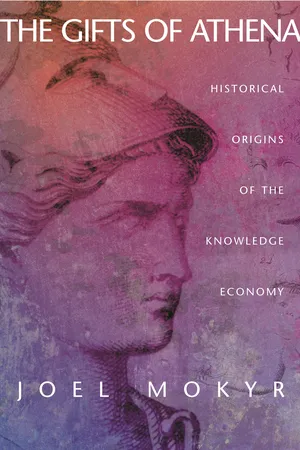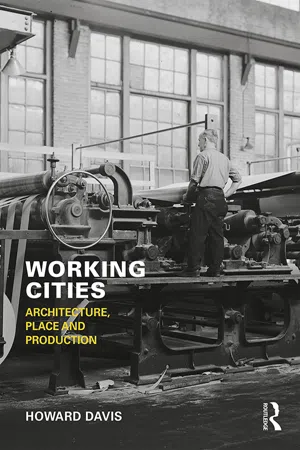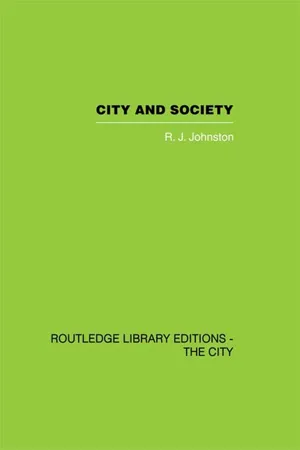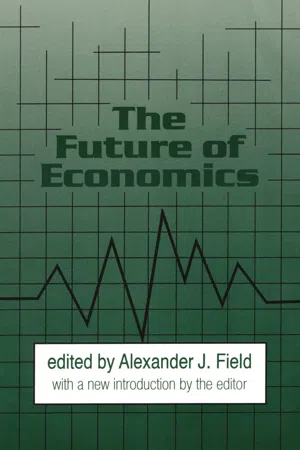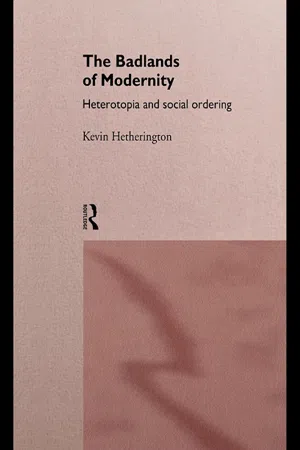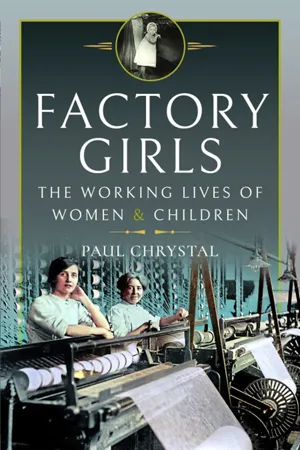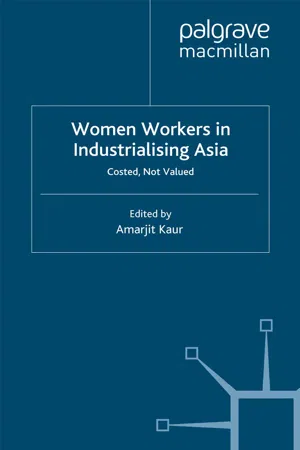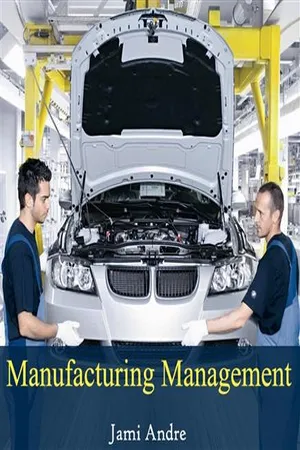History
Factory System
The factory system was a method of manufacturing that emerged during the Industrial Revolution, where goods were produced on a large scale in centralized locations using machinery and a division of labor. This system transformed the way goods were produced, leading to increased efficiency and productivity. It also played a significant role in urbanization and the rise of industrial capitalism.
Written by Perlego with AI-assistance
Related key terms
1 of 5
10 Key excerpts on "Factory System"
- eBook - ePub
The Gifts of Athena
Historical Origins of the Knowledge Economy
- Joel Mokyr(Author)
- 2011(Publication Date)
- Princeton University Press(Publisher)
Chapter 4Technology andthe Factory SystemThe consequences which accompanied the introduction of the modern factory are extraordinarily far-reaching…. Workshop industry meant the employment of the worker in a place which was separate both from the dwelling of the consumer and from his own.—Max Weber, 1923In half a century's time, it may well seem extraordinary that millions ofpeople once trooped from one building (their home) to another (their office) each morning, only to reverse the procedure each evening…Commuting wastes time and building capacity. One building—the home—often stands empty all day; another—the office—usually stands empty all night. All this may strike our grandchildren as bizarre.—Frances Cairncross, 1997IntroductionWhat does technology really do to our lives and well-being? Much of the history of technological revolutions in the past two centuries is written as if the only things that technology affected were output, productivity, and economic welfare as approximated by income. This is of course the best-understood and most widely analyzed aspect of technological progress. Yet technological progress also affected other aspects of the economy that may be significant. Among those is the optimal scale of the basic economic production unit and the location where production takes place. These in turn determine whether “work” will be carried out in a specialized location and thus whether households and firms will be separate physical entities.The stylized fact is that the Industrial Revolution of 1760–1830 witnessed the “rise of the factory.” Like all historical “facts” of its kind, it is only an approximation. In reality, there were numerous precedents for large-scale enterprise and for people working in large plants even before the classical Industrial Revolution. But there can be no doubt that the Industrial Revolution meant the ever-growing physical separation of the unit of consumption (the household) from the unit of production (the plant).1 - eBook - PDF
- Frank W. Thackeray, John E. Findling, Frank W. Thackeray, John E. Findling(Authors)
- 2002(Publication Date)
- Greenwood(Publisher)
The Industrial Revolution should be seen not only as involving techno- logical advance but also as involving change to a variety of institutional and social relationships. One prominent development that points to this complexity is the rise of the factory. The spread of the factory was an evi- dent but dramatic physical change in the overall landscapes of both city and countryside in Britain, as the factory could be located in either setting. Elizabeth Gaskell provides the following description of the arrival of the Hale family in the fictional northern manufacturing town of Milton from a southern rural village in her novel North and South: For several miles before they reached Milton, they saw a deep lead-coloured cloud hanging over the horizon in the direction in which it lay. It was all the darker from contrast with the pale gray-blue of the wintry sky... Nearer to the town, the air had a faint taste and smell of smoke; perhaps, after all, more a loss of the fragrance of grass and herbage than any positive taste or smell. Quick they were whirled over long, straight, hopeless Industrial Revolution 11 streets of regularly built houses, all small and of brick. Here and there a great oblong many windowed factory stood up, like a hen among her chickens, puffing out black, 'unparliamentary' smoke, and sufficiently accounting for the cloud which Marga- ret had taken to foretell rain. Increasingly, production in key manufacturing industries occurred in factories. The factory has been defined in both technological and institu- tional/organizational terms. The defining technological feature of the fac- tory was its use of a central energy source to power machinery, most typically in this period water as well as steam. At the beginning of the nine- teenth century, steam engines were still predominantly associated with mine drainage. By 1850 use of steam had become widespread in textile fac- tories. In 1850,86 percent of cotton textile factories made use of steam. - eBook - PDF
Working Cities
Architecture, Place and Production
- Howard Davis(Author)
- 2019(Publication Date)
- Taylor & Francis(Publisher)
18 Marx, Capital : 1, 492–503. 19 Marx, Capital : 1, 503. 20 Lloyd, The Cutlery Trades , 48. 21 Ure, The Philosophy of Manufactures , 13, quoted in Lloyd, The Cutlery Trades , 48. 22 Tenth Census, U.S. 1880, vol ii, “Manufactures,” quoted in Lloyd, The Cutlery Trades , 49. 23 Langlois, “The coevo-lution of technology and organisation,” 47. FACTORY ZONES 65 My definition: a system of production, housed in a single building or building group, with workers carrying out operations of fabrica-tion and/or assembly that have been determined and supervised by others. Factory design and modernism Before electric motors, power distribution was a major factor in fac-tory design. Water wheels and then steam engines drove mechanical shafts, which were most efficient when linked together with a mini -mum of gear assemblies that changed direction, and with a minimum of total length. Transfers of direction led to inefficiencies and higher likelihood of malfunction. This dictated the use of a single linear shaft often just below the ceiling, each machine connected to the shaft with a continuous vertical belt. And when shafts were still made of wood rather than metal, they were more subject to failure from tor-sional forces—so this limited the total length of the driveshaft, and put, for example, the water wheel below the center of the building rather than at the end, to allow for two shorter driveshafts rather than a single long one. And efficiency was greatest when the machines powered by a shaft were identical. The introduction of electric motors meant that the position of machines was no longer constrained by the geometry of power dis-tribution. But with Taylorism and the assembly line, the efficiency of production itself became the most important factor. - eBook - ePub
City and Society
An Outline for Urban Geography
- R.J. Johnston(Author)
- 2013(Publication Date)
- Routledge(Publisher)
In a workshop with few employees, each individual usually performs all of the tasks involved in the production processes undertaken there. This involves the prior acquisition of a number of skills in an apprenticeship which is lengthy and expensive for the employer; the result is that the product is not cheap. Furthermore, the equipment used in each particular task within the productive process will probably not be required for much of the time (the same is true of the variety of skills learned by the workman). While lying idle, most equipment will deteriorate so that part of the investment in it earns no returns; the more equipment that is needed for a particular workshop, the greater the capital outlay and either the smaller the return on that investment or the longer the period involved in recouping the investment (perhaps paying off the debt incurred when the equipment was bought). To cut costs, and to increase potential profitability, equipment must be used more effectively and efficiently, and this in turn will probably mean more efficient use of labour. The Factory System provided the means of achieving such a goal.In the Factory System each employee is given a single task only, and is responsible for only one piece of machinery (or group of related machines). In performing the one task only he can develop a greater skill at it, and his time does not involve ‘wasted effort’ moving from one task to another; at the same time the machinery is employed continuously, thereby reducing the fixed-cost component of the total production cost. (The fixed-cost component involves the payments for overheads such as machines and buildings, which have to be met whatever the volume of production. The other major component involves varying costs, which include the materials and labour employed. Clearly production is more cost-effective, given a standard price for materials and labour, the lower the fixed costs for each unit produced.) And if the employee is involved in a single task only, he will be less expensive to train since he needs many fewer skills than does the craftsman who performs all of the tasks in the productive process. - E. Royston pike(Author)
- 2013(Publication Date)
- Routledge(Publisher)
THE RISE OF THE Factory System‘Previously to 1760,’ said Arnold Toynbee in one of those lectures delivered to an Oxford audience in 1881 that inaugurated the specialized literature of the Industrial Revolution, ‘the old industrial system obtained in England.’What was the ‘old industrial system’? It has often been described, and almost as often in the most sympathetic terms. One of the best accounts, if by ‘best’ we mean ‘readable’, is that of Peter Gaskell, given in the opening chapter of his book, The Manufacturing Population of England , first published in 1833. Its peculiar quality will be appreciated from what is reprinted here (No. 1). Gaskell disclaimed any intention of painting an Arcadia, but there is none the less about his description a glow of nostalgic warmth.How far Gaskell wrote out of personal knowledge and experience is hard to ascertain, since very little is known about him. He qualified as an apothecary in London in 1827 and in the next year was admitted to the membership of the Royal College of Surgeons. He seems to have lived in the neighbourhood of Stockport, in Cheshire, and it is reasonable to assume that it was then that he obtained his obviously considerable acquaintance with the poor and their problems. The most important thing about him is his book, which, as stated above, was published in 1833; a second edition, revised and slightly enlarged, appeared three years later, under the title of Artisans and Machinery. Gaskell died in 1841, at the age of 35, when he was living in Camberwell, then one of the more rural of the London inner suburbs.Very possibly the book would have remained as obscure as the young surgeon who was its author if it had not attracted the attention of Frederick Engels, the friend and supporter, in more ways than one, of Karl Marx. When he was writing his book on The Condition of the Working Class in England in 1844- eBook - PDF
- Alexander J. Field(Author)
- 2020(Publication Date)
- Routledge(Publisher)
Marx raises the manufacturing period to the status of an historical stage in the development of industrial capitalism, but provides no docu-mentation that manufacture, as he defines it, actually existed-let alone dominated the industrial sector-in Britain from the mid-sixteenth century MARXIAN ECONOMICS 271 to the late eighteenth century. In the last decades of the eighteenth-century and throughout the nineteenth century, nonmechanized capitalist workshops existed alongside, and at times in competition with, the mechanized factory (Samuel 1977; Hobsbawm 1984). But historical research does not support Marx's claim that manufacture-the gather-ing together of large numbers of workers in one location-constituted a significant form of work organization prior to the rise of the Factory System in the last decades of the eighteenth century. What preceded the Factory System was not the manufacturing workshop but rather domestic industry based upon the putting-out system (see Pollard 1968, ch. 2; Rule 1981; Berg, Hudson, and Sonenscher 1983; Ramsay 1984, ch. 3; Berg 1985; Clarkson 1985; Landes 1986). In domestic industry (or outwork, as it came to be called once the Factory System had made its impression), a small group of workers (typically a family) labored independently in their own workplace (typically a portion of the family home) under the direction of a supervising worker (typically the husband and father). If, as was usual in the woollen industry of West Yorkshire in the mid-eighteenth-century, the work group supplied all its own tools, workplace, and materials and had direct access to the product market without the intervention of an outside capitalist, then domestic industry was part of the petty proprietor mode of production. When operated under the putting-out system, however, the capitalist who supplied the domestic workers with materials to be transformed had a direct interest in the quality and quantity of work performed in the labor process. - eBook - ePub
The Badlands of Modernity
Heterotopia and Social Ordering
- Kevin Hetherington(Author)
- 2002(Publication Date)
- Routledge(Publisher)
The main point that Berg and others make is that industrial change has to be situated in local cultural contexts, but she rather romantically treats these as alternate orders, or more specifically like marginal spaces, spaces in which people had a degree of autonomy, found in the form of forgotten modes of production (1985:86). An alternative approach would be to suggest that the factory, which did come into existence in the late eighteenth century in Britain, even if it did not begin to dominate capitalist production until the 1840s, and that as an alternate mode of ordering had an effect of domestic production which, while it did not replace or undermine it, was certainly involved in its reordering. In particular, there was a transformation of the domestic system through the effects of fixed capital. In an industry like cotton, this involved on the one hand the introduction of machines such as the spinning jenny and carding machines into the domestic production environment, and on the other the stimulation of putting-out in the areas surrounding the mills where unfinished machine-made goods were put out to be finished by domestic producers.FACTORY DISCIPLINE AND CONTROL
In accounting for the development of the Factory System, I have indicated above that the two main arguments advanced in the past have been that on the one hand technological changes have been seen as the cause of the move to factory production, and on the other, an ostensibly Marxist argument, that social relations, of which technology was a part, were the reason that factories began to emerge in the late eighteenth century in Britain. A further extension of this position on social relations, following the work of Braverman on the development of the labour process and its relation to capitalism, has been that the control of the workers, in this century through scientific management and deskilling, has been the main reason for factory-based production (1974; see also Marglin 1982):[T]he agglomeration of workers into factories was a natural outgrowth of the putting-out system…whose success had little or nothing to do with the technological superiority of large-scale machinery. The key to the success of the factory as well as its inspiration, was the substitution of capitalists’ for workers’ control of the production process; discipline and supervision could and did reduce costs without being technologically superior. - eBook - PDF
Factory Girls
The Working Lives of Women and Children
- Paul Chrystal(Author)
- 2022(Publication Date)
- Pen and Sword History(Publisher)
24 The Factory System & the Industrial Revolution: Women and Children in those Dark, Satanic Mills The Industrial Revolution … has long been seen as the great historical turning point in the nature of women’s working lives. For with it came a reorganisation of the production process which separated the household from the workplace. M. Berg, Women’s Work and the Industrial Revolution (1992) The immense achievement and horrible iniquity of the factory age. ‘Revolution’ … chronicles in grim detail a time of cruel magnificence. Gerard DeGroot reviewing Peter Ackroyd’s Revolution (2016), The Times, 17 September 2016 The Lombe silk factory The Industrial Revolution (1760–1840) revolutionised the world of work for both men and women. The home was no longer the centre of production, the factory, mill and mine were. Essentially, the Revolution galvanised the transition from hand production methods to machines, new chemical manufacturing and iron production processes, the use of steam and water power, the development of machine tools and the rise and proliferation of the mechanised Factory System. In the early eighteenth century, silk stockings were all the rage amongst the well-to-do, the aristocracy and the royal court. The Italians had been using power spinning since the early fifteenth century, as described by Vittorio Zonca. 1 Leonardo da Vinci had sketched a similar model, but Zonca’s was more complete. England’s centre for silk stocking production by framework knitting had moved to the Midlands from London and the demand for spun silk was soon exceeding supply. Meanwhile, Thomas Lombe (1693–1722) was in London, apprenticed to Samuel Totton, a mercer, and was admitted to the freedom of the Mercers’ Company in 1707. In the same year, he became a freeman of the city of London, and he eventually established himself as a merchant. 2 - eBook - PDF
Women Workers in Industrialising Asia
Costed, Not Valued
- A. Kaur(Author)
- 2016(Publication Date)
- Palgrave Macmillan(Publisher)
for Exportation’, while in 1741 William Hutton noted on his journey from Walsall to Birmingham a ‘prodigious number of blacksmiths’ shops upon the road’, some of which employed as nailers ‘one or more females, stripped of their upper garments, and not overcharged with their lower, wielding the hammer with all the grace of the sex’ (quoted in Pinchbeck, 1930: 278). The Factory System and changing contexts of women’s employment If, therefore, female traditional and domestic work long survived the industrial factories during the nineteenth century, and if various types of wage labour were common in pre-industrial revolution times, in what ways did the industrial revolution mark a decisive era in the history of female wage labour? Of critical importance was the separation of place of work and place of living. In the ‘family economy’ most tasks were home based, and provided a by-employment to seasonal agricultural labour. Working life was village-based and rural-based. The factory, though, disrupted the family economy in terms of economy and location. In place of seasonal 64 Women Workers in Industrialising Asia home work, geared to supplement earnings from agriculture, the factory demanded regular attendance and regular hours. In place of family earn- ings the family member now worked as an individual. Location was determined largely by the availability of power. At first, water-power necessitated factory location in rural, often sparsely-populated regions and a labour force gathered as such conditions demanded. But the adop- tion of steampower soon allowed factories to cluster in rapidly growing industrial towns, and industry became urban, rather than rural based. Another element was the wage. True, money earnings were nothing new. But the factory, and a host of other occupations which arrived with industrialisation, brought earning-power to women and girls on a wholly new scale. At the same time, they brought lower wages for women and children than for men. - No longer available |Learn more
- (Author)
- 2014(Publication Date)
- Orange Apple(Publisher)
____________________ WORLD TECHNOLOGIES ____________________ Chapter- 5 Manufacturing Systems Putting-out System The putting-out system was a means of subcontracting work. It was also known as the workshop system . In putting-out, work was contracted by a central agent to subcontractors who completed the work in their own facility, usually their own home. It was used in the English textile industry, in small farms, and lock making trades as late as the 19th century. Historian David A. Hounshell writes, In 1854, the British obtained their military small arms through a system of contracting with private manufacturers located principally in the Birmingham and London areas ... Although significant variation occurred, almost all of the contractors manufactured parts or fitted them through a highly decentralized, putting-out process using small workshops and highly skilled labor. In small arms making as in lock production, the workshop system rather than the Factory System was the rule. All of the processes were carried out under different cottage roofs. It was replaced by inside contracting and the Factory System. The domestic system was a popular system of cloth production in Europe. It was also used in various other industries, including the manufacture of wrought iron ironware such as pins, pots, and pans for ironmongers. It existed as early as the 15th century but was most prominent in the 17th and 18th centuries. It served as a way for entrepreneurs to bypass the guild system, which was thought to be cumbersome and inflexible. Workers would work from home, manufacturing individual articles from raw materials, then bring them to a central place of business, such as a marketplace or a larger town, to be assembled and sold. The raw materials were often provided by the merchant, who received the finished product, hence the synonymous term putting-out system.
Index pages curate the most relevant extracts from our library of academic textbooks. They’ve been created using an in-house natural language model (NLM), each adding context and meaning to key research topics.
